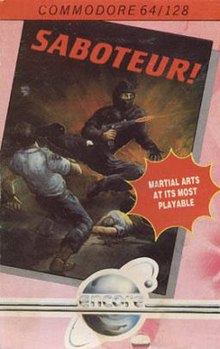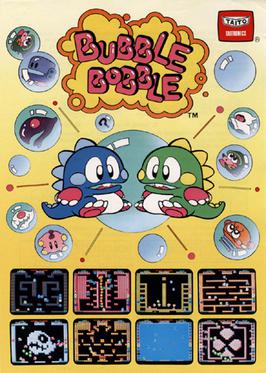
Bubble Bobble is a 1986 platform game developed and published by Taito for arcades. It was distributed in the United States by Romstar, and in Europe by Electrocoin. Players control Bub and Bob, two dragons that set out to save their girlfriends from a world known as the Cave of Monsters. In each level, Bub and Bob must defeat each enemy present by trapping them in bubbles and popping, who turn into bonus items when they hit the ground. There are 100 levels total, each becoming progressively more difficult.

Kid Icarus is a platform video game developed and published by Nintendo for the Family Computer Disk System in Japan and the Nintendo Entertainment System in Europe and North America. It was released in Japan in December 1986, in Europe in February 1987, and in North America in July.

The ZX Spectrum is an 8-bit home computer developed and marketed by Sinclair Research. It is one of the most influential computers ever made, and also one of the best selling computers ever, with over five million units sold. It was first released in the United Kingdom on 23 April 1982, and around the world in the following years, most notably in Europe, the United States, and Eastern Bloc countries.
A stealth game is a type of video game in which the player primarily uses stealth to avoid or overcome opponents. Games in the genre typically allow the player to remain undetected by hiding, sneaking, or using disguises. Some games allow the player to choose between a stealthy approach or directly attacking antagonists, but rewarding the player for greater use of stealth. The genre has employed espionage, counter-terrorism, and rogue themes, with protagonists that are special forces operatives, special agents, secret agents, thieves, ninjas, or assassins. Some games have also combined stealth elements with other genres, such as first-person shooters and also platformers.
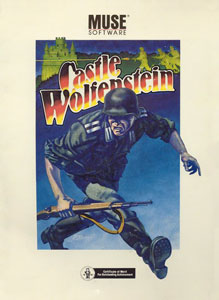
Castle Wolfenstein is a 1981 action-adventure game developed by Silas Warner for the Apple II and published by Muse Software in 1981. It is one of the earliest games based on stealth mechanics. A port to Atari 8-bit computers was released in 1982, followed by Commodore 64 (1983) and MS-DOS (1984).

Metal Gear 2: Solid Snake is a 1990 action-adventure stealth video game developed and published by Konami for the MSX2 computer platform. It serves as a sequel to the MSX2 version of the original Metal Gear, written and designed by series's creator Hideo Kojima, who conceived the game in response to Snake's Revenge, a separately-produced sequel that was being developed at the time for the NES specifically for the North American and European markets. The MSX2 version of Solid Snake was only released in Japan, although Kojima would later direct another sequel titled Metal Gear Solid, which was released worldwide for the PlayStation in 1998 to critical acclaim. This later led to Solid Snake being re-released alongside the original Metal Gear as additional content in the Subsistence version of Metal Gear Solid 3 for the PlayStation 2 in 2005. It was also included in the HD remastered ports of Metal Gear Solid 3 released for PlayStation 3, PlayStation Vita, and Xbox 360, and was given a standalone re-release in Japan as a downloadable game for mobile phones and the Wii Virtual Console.

Bad Dudes Vs. DragonNinja, also known simply as either Bad Dudes or DragonNinja, is a side-scrolling cooperative beat 'em up game developed and released by Data East for arcades in 1988. It was also ported to many computer and game console home systems.

Jetpac is a shooter video game developed and published by Ultimate Play the Game and released for the ZX Spectrum and VIC-20 in 1983 and the BBC Micro in 1984. It is the first game to be released by Ultimate Play the Game, the company which later became Rare. The game follows Jetman as he must rebuild his rocket in order to explore different planets, while simultaneously defending against hostile aliens. It was written by Ultimate co-founder Chris Stamper with graphics designed by his brother, Tim Stamper. Reviewers praised Jetpac's presentation and gameplay, and it won "Game of the Year" at the Golden Joystick Awards in 1983.

Knight Lore is a 1984 action-adventure game developed and published by Ultimate Play the Game, and written by company founders Chris and Tim Stamper. The game is known for its use of isometric graphics, which it further popularized in video games. In Knight Lore, the player character Sabreman has forty days to collect objects throughout a castle and brew a cure to his werewolf curse. Each castle room is depicted in monochrome on its own screen and consists of blocks to climb, obstacles to avoid, and puzzles to solve.
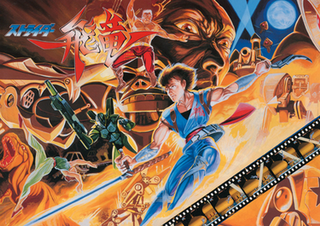
Strider, released in Japan as Strider Hiryū, is a hack-and-slash platform game released in arcades in 1989 by Capcom. Set in a dystopian future where Earth is ruled by the tyrannical Grandmaster Meio, it follows the titular Strider named Hiryu as he attempts to end his tyrannical reign for good. The game resulted from cooperation between Capcom and manga publisher Moto Kikaku. It marked the video game debut of Strider Hiryu, after the character was introduced in the 1988 manga Strider Hiryu.

Durell Software is a software developer based in Taunton, Somerset in the United Kingdom. The company is a provider of back office administration and accounting software to independent financial advisers, mortgage brokers, and general insurance brokers. Durell was formerly a successful video games developer.

Bonanza Bros. is a 3D-style, 2D side-scrolling stealth action game developed and released by Sega in 1990. It is one of the earliest arcade games powered by the Sega System 24 arcade system board. It was ported to various home systems, including the Mega Drive/Genesis, Master System, PC-Engine/TurboGrafx-CD, and several home computers.

Double Dragon is a 1987 beat 'em up video game developed by Technōs Japan and distributed by Taito for arcades across Asia, North America and Europe. It is the first title in the Double Dragon franchise. The game's development was led by Yoshihisa Kishimoto, and it is a spiritual and technological successor to Technos' earlier beat 'em up, Nekketsu Kōha Kunio-kun (1986), released outside of Japan by Taito as Renegade; Kishimoto originally envisioned it as a direct sequel and part of the Kunio-kun series, before making it a new game with a different cast and setting.

Teenage Mutant Ninja Turtles, known as Geki Kame Ninja Den in Japan and Teenage Mutant Hero Turtles in Europe, is a 1989 side-scrolling action-platform game for the Nintendo Entertainment System released by Konami. In North America it was published under Konami's Ultra Games imprint in the US and the equivalent PALCOM brand in Europe and Australia.

Shadow Dancer is a side-scrolling hack-and-slash action game produced by Sega and originally released as an arcade game in 1989. It is the second and the final arcade game in the Shinobi series, following the original Shinobi itself. The player controls a ninja aided by an attack dog, who is fighting to save the city from a terrorist organization.

Bad Street Brawler, originally released for home computers as Bop'n Rumble in North America and as Street Hassle in Europe, is a 1987 video game by Beam Software. Versions were released for the ZX Spectrum and Commodore 64 and MS-DOS by Melbourne House and Mindscape with a NES version following in 1989. The NES version was one of only two games specifically designed for use with Mattel's Power Glove.
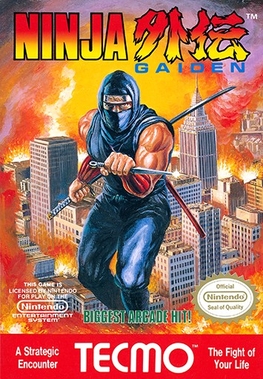
Ninja Gaiden, released in Japan as Ninja Ryūkenden and as Shadow Warriors in Europe, is an action-platform video game developed and published by Tecmo for the Nintendo Entertainment System. Its development and release coincided with the beat 'em up arcade version of the same name. It was released in December 1988 in Japan, in March 1989 in North America, and in August 1991 in Europe. It has been ported to several other platforms, including the PC Engine, the Super NES, and mobile phones.
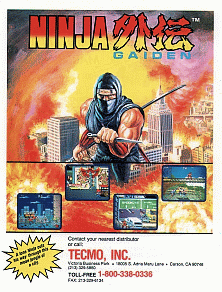
Ninja Gaiden, released in Japan as Ninja Ryūkenden and in Europe as Shadow Warriors, is a 1988 side-scrolling beat-'em-up game, originally released by Tecmo as a coin-operated arcade video game. It was first released in North America and Europe in late 1988, and then in Japan in February 1989. It was the first game released in the Ninja Gaiden franchise. The arcade game was a major commercial success in North America, becoming the highest-grossing arcade conversion kit of 1989 in the United States.
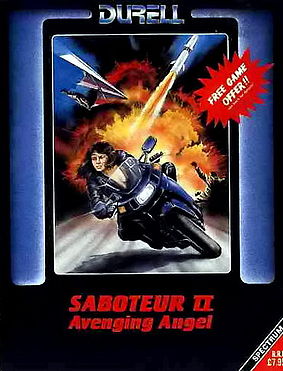
Saboteur II: Avenging Angel, also known as Saboteur 2, is an action-adventure game created by Clive Townsend and released by Durell Software in 1987 for the ZX Spectrum, Amstrad CPC, Commodore 64, and MS-DOS compatible operating systems. A sequel to 1985's Saboteur, the player controls a sister of Ninja from the first game on a mission to avenge his death. Saboteur II was one of the first action-adventure games with a female protagonist and was well received by critics.

Throne of Fire is an action strategy video game. It was designed by Mike Singleton, developed by Consult Computer Systems, and published by Melbourne House. The game was released for the Amstrad CPC and ZX Spectrum in 1987. Throne of Fire is set in the Burning Citadel, located around the rim of a volcano.
